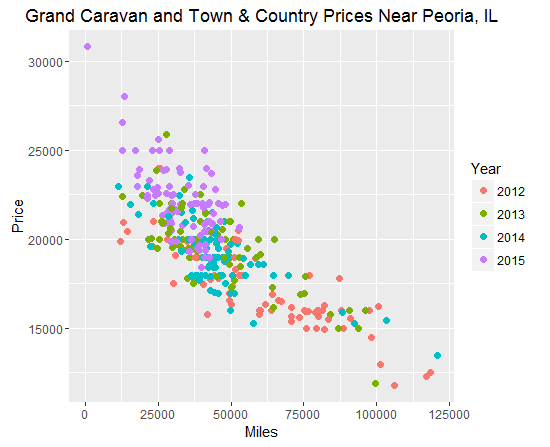By Lucas | June 9, 2016
With my family growing once again and my 13-year-old Mazda Protégé on the fritz, I recently decided it was time to go minivan shopping. A frugal shopper, some might say cheap, I quickly set my focus on the used, domestic market and found that there are only two competitors here, the Dodge Grand Caravan and the Chrysler Town and Country.
Two questions immediately came to mind:
- As these two minivans are, for all practical purposes identical (manufactured at the same facility, same internals, just different branding), if one compared them with a similar set of features, does one name carry a price premium over the other?
- Is there any feature of the price-depreciation curve that is readily observable that one might take advantage of when shopping? Are there advantageous mileages or years to buy?
In order to try to answer these questions, I gathered data from AutoTrader.com. The Grand Caravan/Town & Country was most recently redesigned in 2012, so I collected a total of 350 prices for the model years 2012-2015.
Subject to restrictions from my wife, the minivan had to have power doors/trunk, a backup camera, and a DVD player. It turns out that the entry line model Town and Country Touring meets these requirements, but these features are not guaranteed in the Dodge Grand Caravan until the RT trim line. As such, I only collected prices for models at these trim lines to make the feature set as similar as possible.
First, I plotted the combined set of data points with ggplot2 to try to get a sense of that depreciation curve.

It would appear that all those years that I spent teaching straight-line depreciation to Algebra II students were an exaggeration. The graph does seem to trend a bit more horizontal between around 50,000 miles and 90,000 miles. Then depreciation resumes its previous course. This might be explained in part by the fact that Chrysler offers a 5-year, 100,000-mile power-train warranty on these vehicles, making them a bit more desirable until their warranties expire at 100,000 miles.
Having made the case that this trend is not completely linear, let me nonetheless assume that is is reasonably close enough to use R to fit a linear model to this data. A little bit of exploratory data analysis suggests that the average van owner in this data set drives about 18,000 miles a year, so my variables will be model year, 18K miles, and make (Chrysler or Dodge).
lm(formula = priceK ~ age + miles18K + factor(make), data = training
Coefficients:
(Intercept) age miles18K factor(make)dodge
24.813 -0.412 -1.862 1.317
As we can see, the model suggests approximately a $1300 price premium on the Dodge Grand Caravan. A quick look at the confidence intervals suggests that the Dodge probably really does sell for more.
2.5 % 97.5 % (Intercept) 23.8111303 25.81575484 age -0.7719586 -0.05211861 miles18K -2.2128834 -1.51184676 factor(make)dodge 0.5989757 2.03552222
It’s very possible that the RT trim line carries some additional features that the Town and Country Touring trim line doesn’t, as I am far from a minivan expert. Either way, given the restrictions I was handed, these were the two models and trim lines under consideration for my family, so any significant difference between them was what was of greatest interest to me. For the curious reader, we ended up buying a 2014 Chrysler Town and Country with about 50,000 miles on it, and yes, it did have a negative residual.

